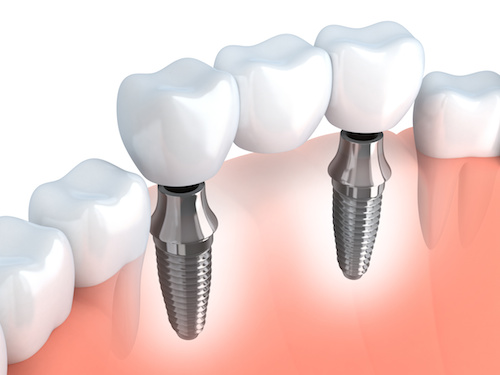
Photo credit: Dollar Photo Club
When a tooth is severely damaged or decayed, sometimes a tooth extraction is necessary. After the tooth is pulled, however, it’s important to replace it to maintain functionality and appearance. The three common solutions to replace a missing tooth are a dental implant, dental bridge and removable partial denture.
Dental Implant
A dental implant is a titanium artificial tooth root that replaces the original tooth root. Just like your real tooth sits in your jawbone, so does the titanium root. Titanium has a special ability: it can “fuse” to bone. This process is called osseointegration – where the bone grows around the threads of the titanium screw, creating a powerful hold, which makes dental implants almost as durable as your natural teeth.
The implant process does take some time and happens in several stages. First, the dentist must place the implant into your jaw. The gum and bone is then allowed ample time to heal over the implant. Once the area is completely healed, the dentist makes an incision in the gum to reveal the implant and place an abutment, which sticks out of the gums as the area around it heals again. Last, a porcelain or gold crown is placed on the abutment.
To be a good candidate for a dental implant, you should be in good health and have healthy gums and adequate bone. In some cases, the dentist may suggest a bone graft to help add quality and quantity to the jawbone before placing the implant.
Dental Bridge
A dental bridge works much like a real bridge, but instead of connecting land, it connects teeth. Typically, a traditional bridge is comprised of at least three pieces that are connected together: a pontic, that replaces the missing tooth and two abutment crowns (one on each side of the pontic).
To place the bridge, the dentist must file down the teeth on each side of the missing tooth. The crowns on the bridge fit over these teeth, allowing the pontic to fit snuggly between them.
If you are interested in replacing your missing tooth with a dental bridge, it’s important that you have healthy teeth to support the bridge. After the bridge is placed, it’s extra important to keep the support teeth clean and healthy by flossing underneath the pontic tooth with the help of floss threaders.
Removable Partial Denture
Removable partial dentures are used to replace one or several missing teeth. They are usually designed to look like both teeth and gums because they sit on your gums, and they typically have clasps, so they can clip to remaining teeth for extra stability. However, they are removable, so the clasps are not cemented to the existing teeth.
As with dental implants and dental bridges, the dentist will need to take an impression of your mouth to build the partial denture. The dentist can do this before your teeth are pulled to craft immediate dentures or wait until the area has healed for conventional dentures. The benefit of immediate dentures is that you can wear them as soon as your teeth are pulled. However, if you have a lot of missing teeth, the bones and gums have a tendency to shrink, causing the immediate partial denture to feel loose and may eventually require a reline to tighten up the fit.
Removable partial dentures are the best replacement option if you suffer from uncontrolled gum disease or similar oral health problem because dentures don’t require you to have a firm jawbone. They are also usually the least expensive option, making them a common choice for people on a tight budget.
Tooth extraction isn’t always necessary, and if that’s the case, your dentist will discuss other options to save the tooth. However, in some cases, there’s no alternative option and there are replacement options. For more information about tooth extraction or replacement, contact Landmark Dental Group today.








 Web Design by Sleepless Media
Web Design by Sleepless Media